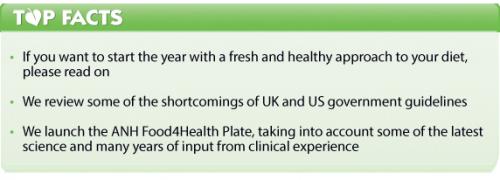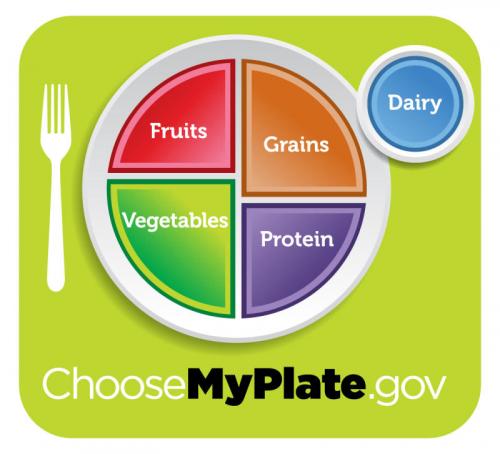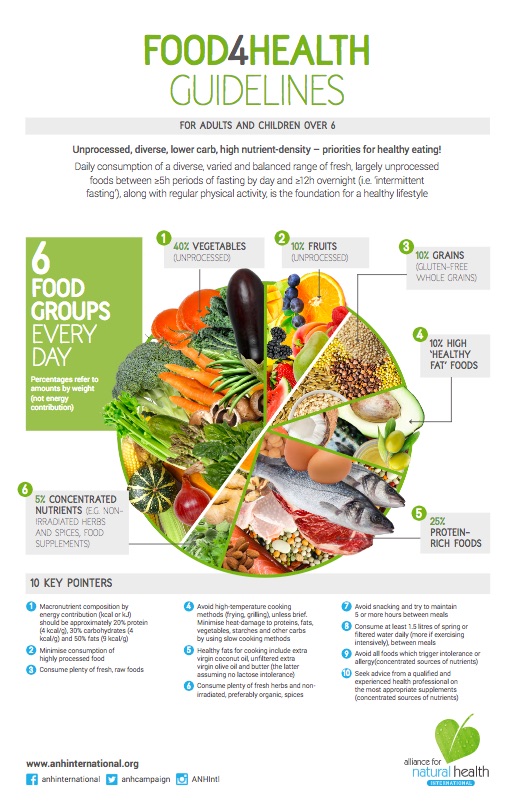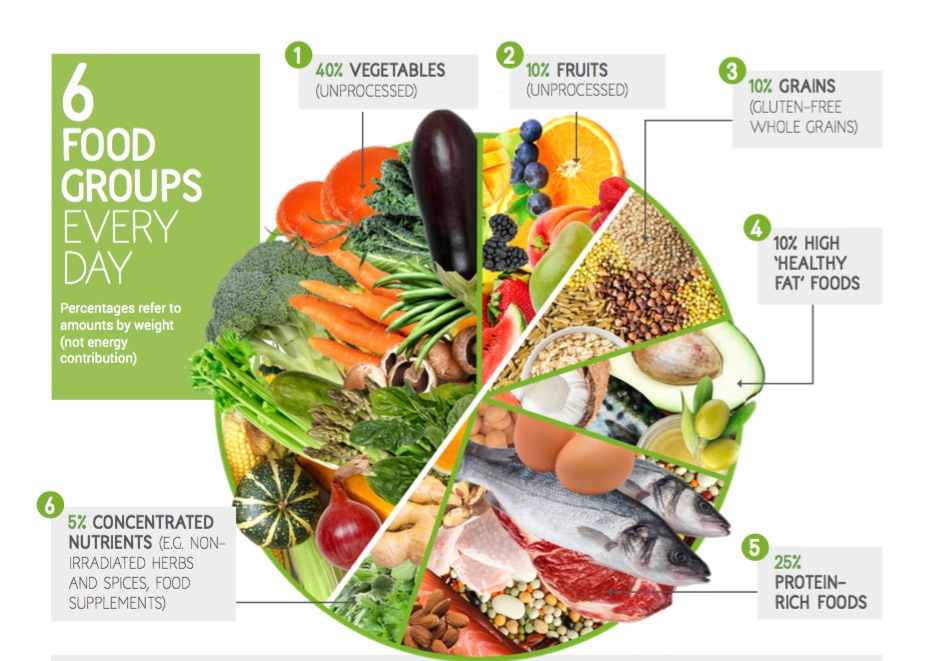Content Sections
You wouldn’t be alone if you’ve decided 2015’s going to be your year of upgrading the quality of your diet. Eating a healthy and balanced diet is key to improving the quality of your life, especially when coupled with regular physical activity and due attention to your emotional health, right? In this piece, we outline some of the reasons why government guidelines are simply not delivering, and why we felt compelled to produce, new for 2015, a guideline ‘plate’ that represents food group composition over a typical day.

Like all guidelines, government guidelines, like our own, are a crude yardstick. Different people’s lifestyles and genetic make-up call for flexibility in any system of guidelines. They therefore should be seen as something of a starting point or a rough guide, not a ‘bible’. Fine-tuning over time is generally needed, a process that can sometimes take years before you find your body’s really singing! But, by contrast, getting your food composition into balance with your evolutionary heritage, avoiding damaged and ultra-processed foods, removing foods to which you’re sensitive and reducing your dependence on refined carbs can deliver results that can often be felt in little more than a day.
Government health warning
In 2010, the UK’s Food Standards Agency (FSA) revised its Eatwell Plate guidelines. The guidelines are intended to help the average person “eat a healthier diet” which is intended to reduce their long-term risk of chronic diseases like obesity, type 2 diabetes, heart disease and cancer. You can find out more about the FSA’s reasoning behind its guidelines by looking at its 2007 nutrient and food based guidelines.
It’s no surprise that governments, faced with the same network of Big Food and Big Ag interests, end up with much the same advice the world over. That’s why the ChooseMyPlate guidance from the US Department of Agriculture (USDA) is not far different to the UK guidelines.
What we do know is that government guidelines are doing little or nothing to buck the trend towards more obesity and other chronic diseases. Is that down to low levels of compliance, or is it because the guidelines are wrong? It’s difficult to be categorically sure. But, interestingly, there is surprisingly little evidence that compliance with dietary guidelines will significantly affect the obesity crisis. This probably strengthens the notion that it’s the guidelines that are defective, not so much public compliance.
For more background, we’ve previously pointed out weaknesses in Western government recommendations.
The need for new guidelines
It’s of course coupling the most relevant published science with clinical experience that gives us the basis for making dietary recommendations. And that’s where the integrative medicine sector, for want of a better name, is in a unique position to provide guidance. As far as we are aware, it is the only sector that is consistently having clinical success treating and preventing chronic disease using dietary interventions. It also routinely has success helping obese individuals to lose weight – and keep it off, even when they are so-called ‘non-responders’. The sector is strongly plugged into, and plays a key role in, pushing forward the boundaries of nutritional science.
Clinical experience is the ‘elephant in the room’ of evidence-based medicine; decision-makers continue to ignore it, worshipping still at the altar of evidence-based medicine (EBM). That’s despite clinical experience being central to the original concept of EBM as proposed by Prof David Sackett and others back in the early 1990s, yet since then having been largely ignored.
‘Ten Terrible Tips’ in government guidelines
In our deliberations with integrative medicine practitioners and nutrition science researchers over the last decade and a half, along with our continual review of the literature, we have consistently had our attention brought to problems with government guidelines. We’ve selected the 10 biggest gripes or ‘terrible tips’ that are consistently raised:
- Starchy carbs are massively over-recommended
- The effect of food processing technologies and cooking on glycaemic load is generally ignored
- Low-fat is still advocated, despite it often being linked to diets high in refined carbs and sugars
- Grains (e.g., cereals, bread, pasta) are recommended as the primary source of energy, despite numerous problems, especially with wheat and gluten, ranging from coelic disease, leaky gut syndrome, non-coeliac gluten-sensitivity and numerous other related gastro-intestinal and autoimmune conditions
- Helping individuals out of food addiction, especially the combined effect of sugar and particular fats, is not adequately taken into account. This issue was graphically illustrated by a BBC experiment on doctor twins, Alexander and Chris and van Tulleken
- There is inadequate emphasis placed on certain food groups, such as healthy fats and concentrated nutrients such as in herbs and spices
- There is little or no consideration of meal/food frequency
- There is little or no consideration of processing, preparation or cooking methods
- There is no provision for supplements, despite evidence of their value in many sub-populations (e.g. Omega-3 fatty acids, vitamin D, multivitamin/minerals, etc.)
- Governments push dairy products to ensure sufficient calcium is consumed. Evidence shows that calcium is not normally deficient in the diet, but rather it is co-factors such as vitamin D, vitamin K2, magnesium and other nutrients that are in too short a supply. Humans did not evolve to consume large quantities of milk from other animals and lactase deficiency is exceedingly common in some populations, ranging from 45-100% in Latin-American populations, to around 90% in Japanese.
On this basis, and to help you with your dietary goals for 2015, we have updated our own advice and release today the ‘ANH Food4Health Plate’. It gives an approximate distribution of the percentage by weight of daily consumption of key food groups. However, our guidelines use a different system of categorisation of food groups compared with government guidelines. Critical to our health is the relative amounts and quality of macronutrients, as well as micronutrients, along with the state of these at the point they enter our bodies.
Alongside this, we have to consider meal frequency, and it is now widely recognised that the snacking culture, that has made it a norm to eat energy-dense foods between meals, not only contributes to excess calories, but also promotes low-grade inflammation that is at the basis of most chronic diseases. Fasting for 5 hours between meals, as proposed by the Metabolic Balance programme, is achievable for most people, albeit requiring a bit of self-discipline in the early stages of becoming a ‘non-snacker’.
Moving from becoming an energy-dense consumer, to a nutrient-dense consumer, is another part of the journey. As is becoming less dependent on simple carbohydrates as your source of fuel. Throughout most of our ancestral past, we have utilised fats as a primary energy source, and rapidly expanding scientific research showing the weight loss, health and endurance benefits of a ketogenic (high fat/protein, low carb) diet can no longer be ignored.
Three guidelines: you choose
At ANH-Intl, we’ve always been great advocates of choice. Guidelines should allow choice and flexibility, especially to take into account huge differences between individuals in relation to their needs and genetics.
We therefore, offer you below, the UK’s Eatwell Plate, the US ChooseMyPlate and now, the ANH Food4Health Plate.
You choose, and not just the plate, but what’s on it! And please give us your feedback by email.
The UK Eatwell Plate
Source: The UK's Eatwell Plate.
The US ChooseMyPlate

Source: USDA Choose My Plate.
The ANH-Intl Food4Health Plate

Download a PDF copy.
End note: get physical, be mindful and rest properly
Nutrition is of course just one of the pillars of health and wellness. You shouldn’t forget to exercise regularly and manage your emotional health.
Government guidelines on physical activity are a little less contentious than the food guidelines. Here’s the UK advice, and the US guidelines.
Better than this, you can get consumer-friendly advice, monitoring and lots of background on how to get the best from all three of the major pillars of wellness: food, physical activity and rest, via our sister organisation, Bite the Sun.
Please help others to benefit from the ANH Food4Health guidelines and share this story widely.
A selection of key references supporting the ANH Food4Health guidelines.









Comments
your voice counts
22 January 2015 at 10:20 pm
where is all the references to back up your claims?
I know the australian guide to healthy eating has masses of evidence (refer to https://www.eatforhealth.gov.au/guidelines/guideline-development which is incredibly comprehensive and detailed research of all available data) you point out that guidelines "should be seen as something of a starting point or a rough guide, not a ‘bible'" and that is exactly how they are designed to be used.
What you appear to be doing is pushing your own version which supports your beliefs. Interestingly if this is how you choose to eat and that works for you most guidelines would accommodate that just as it can for vegans, chronically ill etc. That's where the use of qualified dietitian to assist would help rather than the individual test and try for themselves.
28 January 2015 at 3:03 pm
Thank you for your response. I think we agree that guidelines are guidelines and not rules, and individuals vary in terms of how they respond hence the need to be somewhat flexible. We apologise for not including references in our guidelines and thank you for prompting us to do so. You’ll find a link [http://anhinternational.org/sites/default/files/150128_Selected_references_Food4Health_Plate.pdf] to a partial list of some of the most influential references informing clinical strategies among our collaborating practitioner organisations [http://anhinternational.org/support/1762] at the base of the article.
However, these and many other references aside, we are far more influenced by feedback by clinicians who have adopted these guidelines, than we are by intervention, cohort or epidemiological studies. That is because these generally suffer either excessive over-simplification or, by contrast, confounding by multiple variables. Clinical experience, on the other hand, allows clinician-led, patient-centred, individualised dietary and lifestyle strategies to be closely supervised. We will undoubtedly agree that there is a lack of adequate reporting of such case studies in the scientific literature, but I can assure you if you were to attend major international conferences on the subject, such as those held by the Institute for Functional Medicine, you would soon realise the startling results being obtained by clinicians using these kinds of guidelines.
You might find it hard to pigeon hole them, as they are, on one hand, heavily plant-based, while, on the other, they are relatively high in good quality, undamaged proteins and fats. They are also very low in grain (and very low in, or entirely free of, gluten).
We are fully aware that people have very strong feelings about these issues. We also don’t imagine that the majority of dieticians would agree with ours. But it should perhaps be acknowledged that it is the interpretation of nutrition science by mainstream dieticians (whom you recommend) that are largely responsible for driving large swathes of Western society into insulin resistance, metabolic syndrome and the accompanying chronic disease spiral. Perhaps its time to use a different approach that has been validated my times over in clinical, and especially functional medicine, settings? Furthermore, our guidelines sit far closer to those with which the human genome adapted over millennia. These were among the reasons we considered it both appropriate and timely to offer alternative guidelines, not currently recommended by governments.
26 January 2015 at 6:15 pm
Nutrition is all about balancing diet and emotions...Great piece of information...
27 January 2015 at 7:51 pm
From experience with many clients over the years, I would support the criticism of the UK's Eatwell Plate, that always seems antiquated. However, I have 2 points to make: isn't the 'eat well plate' better than nothing for most people in the UK? I don't know many who even follow half of these recommendations....secondly, I don't agree with one principle of the 'new' revised plate guidelines that suggests one should 'fast' for 5 hours between meals. Again, from experience with many people who suffer from low blood sugar issues (leading to rampant sugar cravings), I would always suggest eating every 3 to 4 hours at most.
The last comment suggesting the use of a qualified dietitian is definitely right in my opinion, as I feel it's not helpful to have a 'one size fits all' plate or general guidelines.
30 January 2015 at 5:17 pm
Thank you for your comment. We fully agree that the UK Eatwell Plate is better than none and sometimes these policy decisions, such as the 5 A DAY programme, are an attempt to move people in the right direction while not being perceived to be too difficult to ensure compliance. The issue is that for those who have a higher degree of health awareness, they can definitely alter their nutritional patterns to improve long-term health, and it is really for this second group that the Food4Health guidelines are intended. Regarding the 5-hour fasting period between meals, this has been widely used by practitioners of Metabolic Balance all over Europe and elsewhere for many years now and, following a short period of metabolic adaptation, can be extremely helpful in overcoming insulin resistance and metabolic syndrome. Part of this adaptation process is linked to overcoming sugar addiction which has now been well associated with opioid receptors in the nucleus accumbens. Important during this phase of metabolic adaptation is minimising any intense exercise. With regards to your final point the challenge here is that there are few dieticians that we have encountered that are sufficiently immersed in some of the most relevant aspects of clinical nutrition and clinical practice that are aimed at directly resolving imbalances in energy utilisation and storage. The 2 groups we feel are well educated in these issues are functional medicine, and clinical psychoneuroimmunology (cPNI) practitioners
30 January 2015 at 3:33 am
I disagree with the still very high carb content of your plate. Even though it comes from fruit and veg...it still elicits insulin response and a glucose molecule is still a glucose molecule....
Through gluconeogenesis the body can make its own glucose for fuel and our ancestors were hunter/gatherers - therefore relied heavily on fat (which you recommend as a mere and very unfortunate 10% daily intake) and protein.
There are 9 essential amino acids, 2 essential fatty acids but no such thing as an essential carbohydrate.
30 January 2015 at 6:14 pm
Thank you for your comment. We're not sure that we agree that the Food4Health plate is a high carb plate. You'll see our follow-up piece this coming Wednesday. While 50% of the volume might come from carbs, the low fruit/higher vegetable quotient keeps the carb contribution to daily energy quite low. It's also low GI/GL. You'll see in our piece next week that total carbs as a contribution to daily energy ends up typically being around 30%, the rest balanced fairly evenly between protein and fats.
30 January 2015 at 10:32 pm
The ANH do great work on enabling us to follow the science and corruption in the food and pharma industries, but WHY have they taken so long to acknowledge the dietary advice is so faulty and still not exposing the the evidence from the simple concepts and science of the Low Carb High Fat dietary way of life. There are ever increasing personal stories from people who have changed their lives making the very easy change to following the simple advice on LCHF. Many have given out the same advice, I am copying Dr. Lutz's summary as published in his book Life Without Bread:
QUOTE:
THE BASICS
Permitted Foods:
• Fish
• Any type of animal meat (beef, pork, chicken, lamb), sausage, cold cuts
• Eggs
• Cheese, sour cream, cream cheese, plain yogurt (without sugar), cream, milk (in moderate amounts)
• All kinds of animal fats
• Salads, leaves and stems of vegetables (asparagus, brussel sprouts, cauliflower, lettuce, cabbage, broccoli), cucumbers, avocados, tomatoes (in moderate amounts)
• Alcoholic beverages (only unsweetened and in sensible amounts)
• Nuts (in moderate amounts)
These foods can be prepared any way you like: fried, baked, roasted, broiled, barbecued, or steamed. Small amounts of breading and sauces don’t count toward the 72 grams of carbohydrate per day. Larger amounts will have to be counted, particularly if the sauce is mostly sugar-based (beware of typical barbecue sauces and sweet-and-sour sauces).
Restricted Foods
• All carbohydrate-containing foods (breads, pastas, cereals, grains, potatoes, pastries, bagels)
• Sweet fruits
• Sweetened foods of all kinds (yoghurt, drinks, desserts, candy)
• Dried Fruits
Now, this sounds easy, doesn’t it? You can eat as much fat and protein as you want, as long as you keep the carbohydrates to 72grams or less per day. And don’t skimp on the fat. It is important to eat plenty of fat when you reduce carbohydrates; don’t rely on protein only. END QUOTE
Time to put a halt to the fear of eating saturated fats - the only evidence today is that stopping the population eating it has driven the many health issues associated with metabolic syndrome.
12 February 2015 at 12:37 pm
Working with a nutritional therapist who is trained in energy therapy will help you work out the best food combination for you. Everyone is biologically unique so there can be no one size fits all.
23 April 2015 at 8:53 am
I did an _extended_ water fast followed by a frugivore diet (entirely fruit including avocado with a few veggies like lettuce and spinach) for 5 months and cured myself of multiple chemical sensitivity that I had had for 25 years. The paranoia about the sugar in fruit is unwarranted at least on an all -fruit diet.
14 July 2016 at 3:33 pm
Love the ANH Food4Health Plate. Do you have a pdf format of the poster so that we can share at schools and to Nutritionists that can share it with clients ?
14 July 2016 at 4:27 pm
Hi Barbara,
We are so glad to hear that you like it. We certaintly do have a PDF version available. It can be found on the Food4Health campaign page: http://anhinternational.org/campaign/food4health/ under the Food4Health plate and Food4Kids plate links at the top of the page.
I hope this is helpful.
All the best,
Susie
Your voice counts
We welcome your comments and are very interested in your point of view, but we ask that you keep them relevant to the article, that they be civil and without commercial links. All comments are moderated prior to being published. We reserve the right to edit or not publish comments that we consider abusive or offensive.
There is extra content here from a third party provider. You will be unable to see this content unless you agree to allow Content Cookies. Cookie Preferences